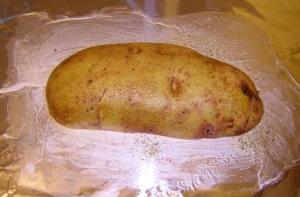The baked potato has been a popular dinner item for a very long time. Potatoes in general have been used as a food item for centuries in the Andes. The Spanish brought this versatile plant back to Europe, and by the 18th century it was becoming a staple in the diet of many people. Potatoes are a good source of a number of vitamins including vitamins C, B6, niacin, magnesium, and iron. Much of the nutrition in the potato is in the skin, so if you peel it you are throwing away most of your vitamins.
Today’s recipe is a variation on the average baked potato that my sweetheart introduced me to. The process is very simple and the results are very tasty.
- Give your potato a good scrubbing and pat dry with a paper towel.
- Use a damp cloth to spread a thin layer of moisture on your counter and place two pieces of aluminum foil (about 1 foot square) on top of the damp area per potato. The moisture will help keep the foil from sliding around during the next step.
- Using a stick of unsalted butter, coat the foil where the potato will be placed. I try for an area about 1 or 2 inches larger than the potato.
- Sprinkle on some garlic powder, onion powder, and Mrs. Dash. Smokey paprika, cayenne pepper, and parsley are some other herbs to select from as well.
- Cut your potato in half. You want to cut along the narrow side so that you have a large cut surface and a mostly flat potato. Be very careful doing this so that you don’t cut yourself.
- Place the cut pieces cut side down on the butter and seasonings.
- Fold the foil around the potato and place in a 400 degree oven for at least one hour.
The butter and the seasonings seem to soak into the potato and the result is very tasty. You can pre-prep your potatoes in advance and put them in the fridge till you are ready to bake them; however, I would not do this more than one day in advance. Remember that a cold potato will take a bit longer to bake than one at room temperature.
One word of caution about the potato: it is a member of the nightshade family. There are some people who are sensitive to plants in this family. Also, anyone who suffers from arthritis should avoid eating any food that is a member of the nightshade family.


